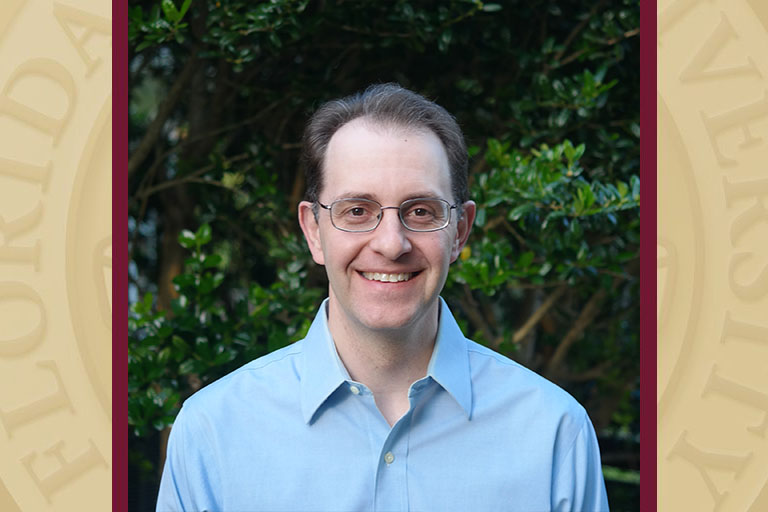
A Florida State University cosmologist has been selected to co-lead a Department of Energy and National Science Foundation project investigating the faint leftover radiation from the Big Bang known as the cosmic microwave background, or CMB.
FSU Associate Professor of Physics Kevin Huffenberger and University of Chicago Associate Professor of Astronomy and Astrophysics Jeff McMahon will serve as co-spokespersons for the so-called CMB-S4 science collaboration, a project to provide insight into the most energetic processes in the universe and probe physics from the universe to subatomic particles.
Huffenberger and McMahon were elected by the CMB-S4 collaboration membership and will begin their two-year appointments in July.
“I’m excited to engage in this leadership role in the CMB-S4 collaboration,” Huffenberger said. “The project will generate huge amounts of new knowledge about fundamental physics, cosmology and astrophysics, and it is amazing to get to work on such things. I’m honored and grateful to my colleagues for electing me.”
CMB radiation documents the conditions 400,000 years after the Big Bang, early in the universe’s 14-billion-year history, and slight variations in the temperature of the incoming radiation carry information about the early universe. Scientists measure the CMB by scanning the sky with a specialized telescope and then assembling the scanning data into maps of the sky. Huffenberger’s main area of study is figuring out how to reliably draw conclusions about the contents and properties of the universe from those primeval images.
CMB-S4 comprises an ambitious network of observatories at sites in Chile and Antarctica that will survey the sky for seven years and map the cosmic microwave background to unprecedented precision. The project includes plans to build several new instruments, including three 6-meter and 18 half-meter telescopes and 500,000 ultrasensitive detectors.
This project will enable scientists to search for signatures of gravitational waves from the dawn of time, examine the nature of dark matter and energy, map matter throughout the universe and capture astronomical occurrences such as gamma-ray bursts or tidal disruption events — stars that are pulled apart by a black hole’s gravity. CMB-S4 will also help to measure the mass of the neutrino, an extremely small and mysterious particle.
“Because CMB-S4 will contain 10 times as many detectors as any experiment that precedes it, it will provide us a much clearer picture of the early universe. That clarity will let us better measure the distribution of primeval material, and also its motion, in ways that can reveal as-yet-unseen physical effects or unknown physical laws,” Huffenberger said. “We may see gravitational waves that were generated in the universe’s first fraction of a second or discover new subatomic particles whose presence is affecting the flow of material in the primordial plasma.”
CMB-S4 was formally established in 2018 and now includes 390 members at 118 institutions spread across 27 U.S. states and 19 countries.
“One thing that excites me the most is that we might be able to see the signature of primordial gravitational waves, which will be the highest energy physics that have ever been probed,” said McMahon, an experimentalist who has played key roles on earlier CMB projects in Chile and at the South Pole. “This will be a revolutionary physics measurement and provide fundamental information about how the universe began.”
Huffenberger and McMahon will succeed co-spokespersons John Carlstrom, from the University of Chicago, and Julian Borrill, senior scientist at the Computational Cosmology Center at the Berkeley National Lab and senior research physicist at the Space Sciences Laboratory at UC Berkeley.
“I am delighted that Jeff and Kevin have been elected as co-spokespersons, and I am excited to begin working with them as they lead the Collaboration and serve as the primary interface with the project,” said John Corlett, director of the CMB-S4 project office at Lawrence Berkeley National Laboratory. “John Carlstrom and Julian Borrill have made terrific contributions to the Collaboration and to the project and remain in their senior roles within the project. I look forward to building CMB-S4 project momentum with Jeff and Kevin.”
Huffenberger, a native of Columbus, Ohio, earned degrees in mathematics and physics at the University of Illinois before earning a doctorate in physics from Princeton University. He worked as a postdoctoral fellow at the California Institute of Technology and NASA’s Jet Propulsion Laboratory before joining the faculty at the University of Miami. He has worked in the astrophysics group in Florida State University’s Department of Physics, part of the College of Arts and Sciences, since 2013.




